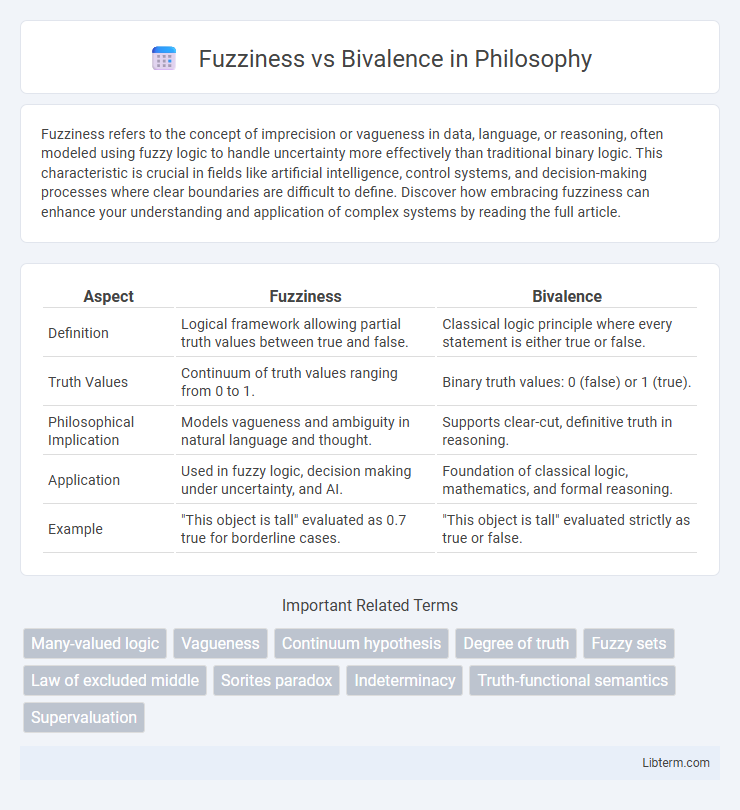Fuzziness refers to the concept of imprecision or vagueness in data, language, or reasoning, often modeled using fuzzy logic to handle uncertainty more effectively than traditional binary logic. This characteristic is crucial in fields like artificial intelligence, control systems, and decision-making processes where clear boundaries are difficult to define. Discover how embracing fuzziness can enhance your understanding and application of complex systems by reading the full article.
Table of Comparison
| Aspect | Fuzziness | Bivalence |
|---|---|---|
| Definition | Logical framework allowing partial truth values between true and false. | Classical logic principle where every statement is either true or false. |
| Truth Values | Continuum of truth values ranging from 0 to 1. | Binary truth values: 0 (false) or 1 (true). |
| Philosophical Implication | Models vagueness and ambiguity in natural language and thought. | Supports clear-cut, definitive truth in reasoning. |
| Application | Used in fuzzy logic, decision making under uncertainty, and AI. | Foundation of classical logic, mathematics, and formal reasoning. |
| Example | "This object is tall" evaluated as 0.7 true for borderline cases. | "This object is tall" evaluated strictly as true or false. |
Understanding Fuzziness in Logic
Fuzziness in logic extends beyond classical bivalence by allowing truth values to range continuously between 0 and 1, representing degrees of truth rather than absolute true or false states. This approach enhances modeling of real-world scenarios where uncertainty, ambiguity, and partial truth are prevalent, such as in control systems and decision-making processes. Understanding fuzziness involves grasping how fuzzy sets and membership functions quantify imprecision, enabling more flexible and realistic reasoning compared to traditional binary logic.
The Principle of Bivalence Explained
The Principle of Bivalence states that every proposition is either true or false, with no middle ground, reflecting classical logic's binary framework. This principle contrasts with fuzziness, which allows for degrees of truth and recognizes that some statements may be partially true and partially false simultaneously. Bivalence underpins traditional logical systems and ensures crisp decision-making, while fuzziness provides a more nuanced approach suitable for complex, real-world scenarios where boundaries are not sharply defined.
Key Differences Between Fuzziness and Bivalence
Fuzziness allows partial truth values between 0 and 1, representing degrees of membership in fuzzy logic, whereas bivalence strictly adheres to classical logic with only two truth values: true or false. In fuzzy systems, statements can be simultaneously partially true and partially false, contrasting with bivalence where every proposition must be precisely true or false. This fundamental difference enables fuzzy logic to model uncertainty and vagueness more effectively than the rigid binary framework of bivalent logic.
Historical Background of Fuzziness and Bivalence
The historical background of bivalence traces back to classical logic, where it was formalized by Aristotle's law of excluded middle, asserting that every proposition is either true or false. Fuzziness emerged in the mid-20th century with Lotfi Zadeh's introduction of fuzzy set theory in 1965, challenging the rigid dichotomy by allowing truth values to range between 0 and 1. This evolution marked a significant departure from binary logic, enabling more nuanced reasoning in fields such as artificial intelligence and decision-making.
Applications of Fuzzy Logic in Modern Technology
Fuzzy logic enables decision-making in systems with uncertainty and imprecision, contrasting with classical bivalence which relies on strict true or false values. Its applications span diverse fields such as control systems, where fuzzy logic optimizes air conditioning and automotive transmission, and data analysis, enhancing pattern recognition in medical diagnostics. Emerging technologies like autonomous vehicles and smart grids leverage fuzzy logic to process ambiguous information, improving adaptability and efficiency.
Bivalence in Classical Logic Systems
Bivalence in classical logic systems asserts that every proposition is either true or false, with no intermediate truth values allowed. This principle underpins classical logic's binary framework, enabling definitive truth evaluations and clear-cut reasoning processes. Unlike fuzzy logic, classical logic's bivalence excludes degrees of truth, ensuring crisp, unambiguous conclusions in mathematical proofs and formal systems.
Advantages and Limitations of Fuzziness
Fuzziness enables more nuanced reasoning by accommodating degrees of truth between 0 and 1, in contrast to bivalence's rigid true/false framework, making it ideal for modeling real-world uncertainty and imprecision. Its advantage lies in enhanced flexibility and better handling of ambiguous or incomplete information, improving decision-making in complex systems such as artificial intelligence and control engineering. However, fuzziness can introduce computational complexity and interpretability challenges, limiting its straightforward application in contexts requiring clear-cut, binary outcomes.
Strengths and Weaknesses of Bivalence
Bivalence, the principle that every proposition is either true or false, offers clear-cut decision-making and logical precision, making it foundational for classical logic systems and binary computation. Its strength lies in simplicity and unambiguous evaluation, which facilitates formal reasoning and algorithmic implementation. However, bivalence struggles with vagueness and borderline cases found in natural language and real-world scenarios, limiting its ability to model uncertainty or partial truth effectively.
Real-World Examples: Fuzziness vs Bivalence
Fuzziness better captures real-world scenarios like weather prediction and medical diagnosis, where outcomes exist on a spectrum rather than being strictly true or false. Bivalence assumes strict binary states, as seen in classical logic systems used in digital circuits and formal mathematics. The practical application of fuzziness addresses uncertainties and gradations, reflecting natural complexity more accurately than bivalent models.
Choosing Between Fuzziness and Bivalence in Problem Solving
Choosing between fuzziness and bivalence in problem solving depends on the complexity and nature of the information involved. Fuzziness allows modeling uncertainty and partial truths, making it ideal for real-world scenarios with ambiguous data or imprecise boundaries. Bivalence, based on true/false dichotomy, suits problems requiring clear, definitive answers where binary logic applies effectively.
Fuzziness Infographic

 libterm.com
libterm.com